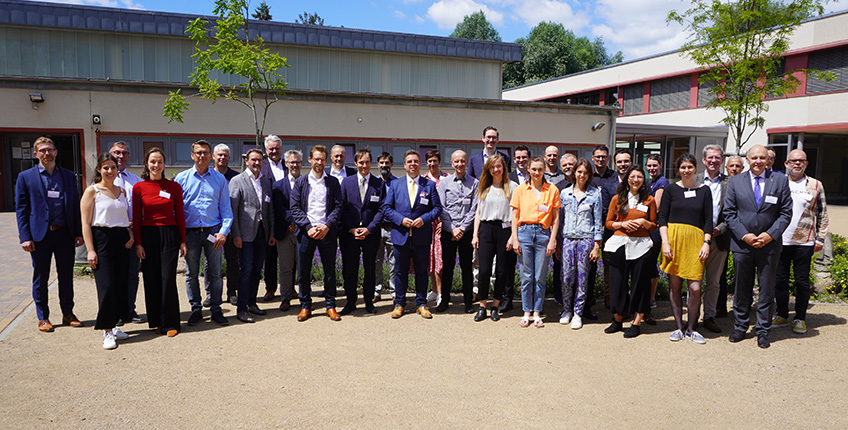In the H2VL project, scientific and consultancy experts examined how the entire hydrogen value chain, consisting of production, storage, distribution and use, can be brought together for the Havelland district. The experts presented the results of their hydrogen feasibility project in a final workshop last Wednesday in Nauen.
The project team was able to identify and network local players along the value chain as well as support them in implementing their projects. From production and distribution, right along to hydrogen use, all parts of the value chain were addressed. One of the core findings was that Havelland has very good conditions for conducting a diverse array of H2 projects. A major locational advantage is that Havelland shows great potential for expanding renewable energies and therefore, for generating renewable (green) hydrogen. It is crucial for the implementation of the project that Havelland residents themselves benefit from this potential.
Around 40 participants on location in Nauen as well as online participants demonstrated great interest in the presentation of the study. Project consortium representatives presented the most important findings. The project was carried out by the Reiner Lemoine Institute (RLI), Ingenieurgesellschaft Auto und Verkehr (IAV), Consulting for Drive (C4D) and the Institute for Climate Protection, Energy and Mobility (IKEM).
Cooperation with local H2 stakeholders was an important task of the H2VL initiative. The project team hosted various formats. In bilateral discussions and local meetings, the focus was on relationship-building. In addition, all stakeholders were systemically asked for data on planned H2 projects in a survey. In a total of nine workshops, participants were able to network with each other and get to know projects both within and outside the Havelland district. This facilitated networking among stakeholders and the level of cooperation was intensified.
Two hydrogen clusters were developed in the project that are to boost both the ramp-up of the H2 economy as well as benefit the region. In the East Havelland cluster, energy provider GASAG and its subsidiary Energie Mark Brandenburg (EMB) are planning the operation of an electrolyser – a mechanism which splits water into hydrogen and oxygen with the aid of electrical current – at the energy transition laboratory site in Ketzin/Havel. The green hydrogen produced there can be used in municipal vehicle fleets in Nauen that are not suitable for battery-electric operation. The waste heat from the electrolyser can also be incorporated into the gas transfer station in Ketzin/Havel and can thereby replace boiler heat. The cluster was examined in terms of its economic viability as well as site-related factors and has good chances of being realized.
“We have been planning an electrolyser plant at the energy transition laboratory site in Ketzin for some time. The acquisition of hydrogen-powered vehicles for municipal fleets in Nauen generates a sustainable source of consumption for regionally-produced green hydrogen. This will enable the project to be implemented in a timely manner”, said Reinier Waters, Head of GASAG hydrogen activities.
In the West Havelland cluster, the focus was on a more climate-friendly generation of district heating. Through the direct use of wind electricity, district heating in Rathenow was able to be decarbonized, in other words, carbon and CO2 emissions were reduced. Surplus electricity from the wind turbines can be used to generate hydrogen and be made available for municipal mobility. Two driving stakeholders in this project are Rathenower Wärmeversorgung (Rathenow Heat Supply) as well as Wasser- und Abwasserverband Rathenow (Rathenow Water and Waste Water Association). “By using wind electricity from a municipal wind farm in the immediate vicinity, the possibility exists of decisively advancing the transport transition and heating transition through hydrogen generation and power to heat at economic prices in Rathenow”, said Günther Rall, Managing Director of Rathenower Wärmeversorgung.
The completion of the H2VL project in Havelland is not the end, but rather the beginning of building a hydrogen economy. For the district to be able to achieve its climate objectives, it is important to reduce greenhouse gas emissions, particularly in the transport and heating sectors. That is why Havelland is also planning a review of its own options for using hydrogen. Furthermore, close cooperation with cluster stakeholders will be pursued to oversee and support their projects in the longer term as well.
District Administrator Roger Lewandowski has high expectations of how hydrogen projects will develop in the future in Havelland: “Using hydrogen and incorporating this alternative energy carrier in a regional value chain gives us the opportunity to strengthen local economic sectors and to use and meet the demand for energy in a sustainable way, particularly for the local heating and mobility sectors. With our participation as a HyExpert model region and with partner networking, we have laid the foundations not just for thinking about the development of an entire value chain – from product and storage right up to use of hydrogen – but for taking the first steps to implementing some projects. We want to continue to work intensively on this with all study participants as well as other interested parties.”
Havelland was one of 15 HyExpert regions chosen under the framework of the National Innovation Programme for Hydrogen and Fuel Cell Technology (NIP2). It received funding of almost 400,000 euros from the Federal Ministry for Digital and Transport. The funding guideline is coordinated by NOW GmbH and implemented by Project Management Jülich (PtJ). For further information on the project and its progress, you can contact and visit the website: www.h2vl.de.
Image: Participants of the H2VL final workshop in Nauen.
Image rights: Havelland district
Source of original release: Havelland district


